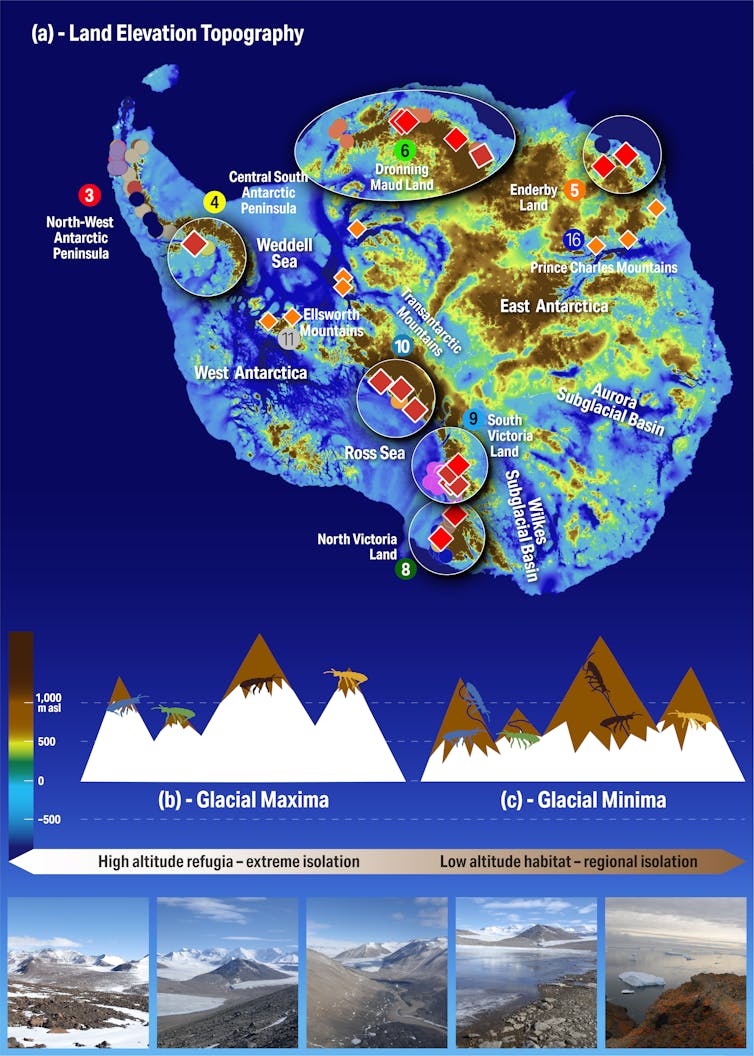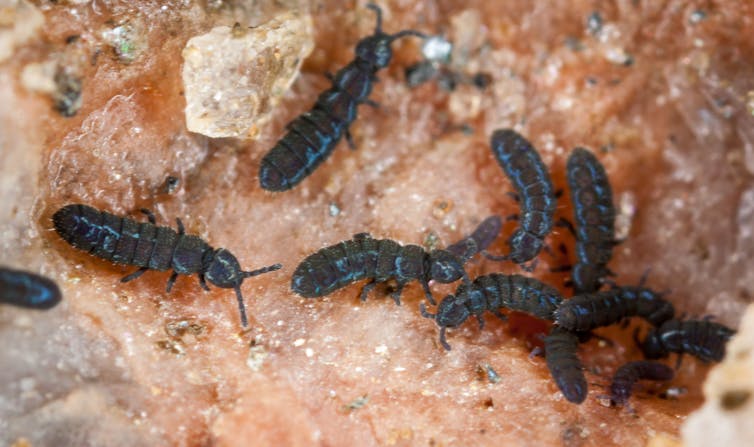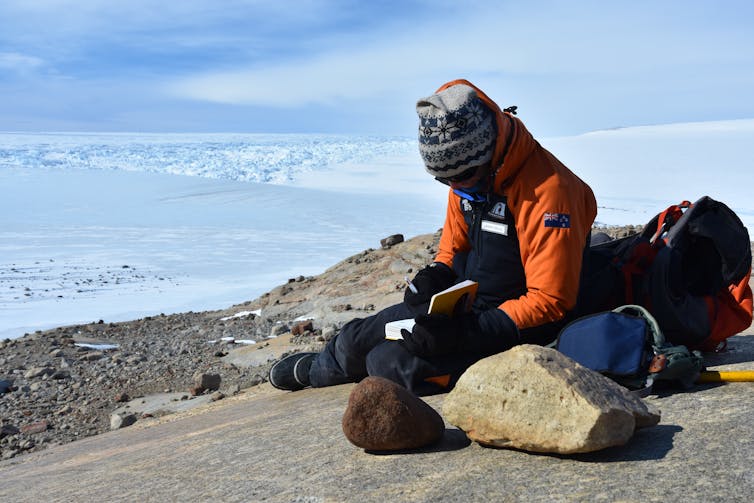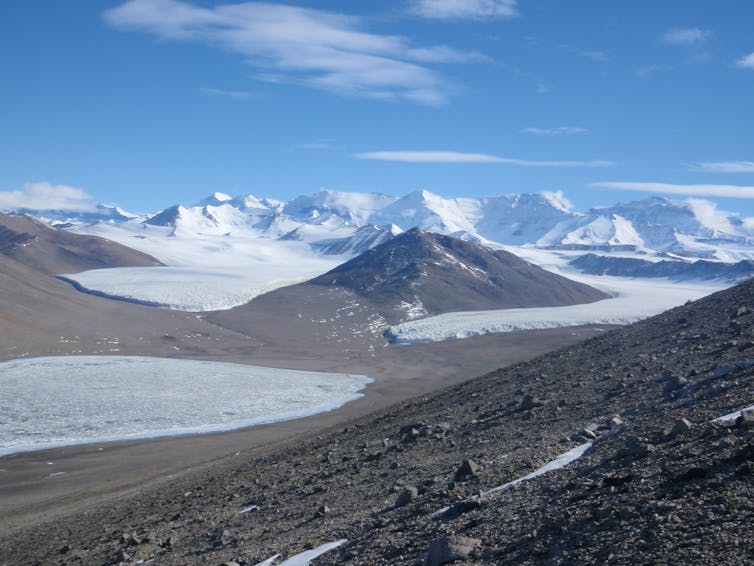Source: The Conversation (Au and NZ) – By Mark Stevens, Adjunct Associate Professor, University of Adelaide
Antarctica is an icy place today, but the ice extended even further during past ice ages. The question of how and where life survived on land in the icy continent, through the ages, has long puzzled biologists.
Ever since the first expeditions to Antarctica, the persistence of life in this inhospitable environment has remained a mystery. Until now.
We assembled data to test our theory of how life survived previous ice ages. We argue that life forms including invertebrates, vertebrates and plants persisted by retreating to numerous ice-free areas, called nunataks, that were not buried by advancing glaciers.
Then when Antarctica gradually warmed up again, life expanded from these nunatak refuges to repopulate larger ice-free areas. Our approach explains the uneven distribution of Antarctic terrestrial life, and identifies new research priorities to test our theory further.
The coming age of ice
There may be some truth to this story. The idea of a mammoth, sloth, sabretooth tiger (and pesky humans) migrating south for warmer climes is becoming well known in the Northern Hemisphere. And research published this month suggests early humans sat out the last ice age in the ice-free refuges of southern Europe.
But in Antarctica, land-loving life forms had nowhere to go. Or so it seemed, until now.
As scientists began to learn more about life in Antarctica, they began to consider the possibility of survival in ice-free refuges. But there was a problem. Any ice-free land in coastal regions, where life exists today, would have surely been consumed by the expanding ice. So how did life survive?
Unusual ice-free refuges
Using evidence from the biology and geology of Antarctica, we describe how ice-free refuges (nunataks) could have provided respite for coastal species.

Biology Letters, CC BY
We discounted previous research suggesting geothermal sites provided sufficient ice-free refuges on the coast. That’s because these would have been short-lived – compared to an ice age lasting around 100,000 years – and too few in number to explain the survival of life on the continent today.
We provide the first testable evidence-based hypothesis for the existence of life on continental Antarctica for millions of years. And we achieved this using the most well-known of all Antarctic invertebrates, a small creature that inhabits ice-free land year-round: springtails.
Springtails are an important contributor to soil health globally. They were among the first animals collected during early expeditions to the Antarctic Peninsula and the northern coast of Victoria Land from 1897-1900.
We collated a database of distribution records for Antarctic springtails from these first discoveries more than a century ago to the present.
Read more:
200 years of exploring Antarctica – the world’s coldest, most forbidding and most peaceful continent

Cyrille D’Haese
We also delved into an existing resource that has not been previously used to explore these questions of survival. By exploring the Informal Cosmogenic-nuclide Exposure-age Database (ICE-D) for Antarctica, we were able to demonstrate that ice-free conditions persisted across the last (and previous) ice ages at a large number of locations.
Cosmogenic-nuclide dating is normally used to improve the understanding of ice sheets’ response to climate change, by revealing when a rock was last covered by ice. But it had not been used to identify ice-free glacial refuges, until now.

Andrew Mackintosh, Author provided
We show that some of these ice-free refuges persisted above the expanding ice during past ice ages. Some contained all species found in a region.
But how did life move from these refuges, to repopulate habitats such as coastal areas? Clues to this remarkable survival story comes from well-known alpine and polar studies, showing life present in ice-free ecosystems near glacial margins shifts as the ice expands or contracts.

Kevin Norton and Richard Jones
Learning life lessons
Antarctic life faces an uncertain future as the climate changes. The region is experiencing more extreme events such as the catastrophic breakup of ice shelves, the highest observed Antarctic air temperature, and the least extensive sea ice ever recorded. It seems we are now living in the sequel “Ice Age: The Meltdown”. Let’s hope we fare as well as Manny and his friends.
Read more:
The Antarctic ice sheet is melting. And this is bad news for humanity
Antarctica will change forever, and limiting that change will take a “mammoth” collective effort at a global scale to rapidly reduce greenhouse gas emissions. This is a daunting and unprecedented challenge, but one which is required to secure Antarctica’s future. Life endured past ice ages, but can it survive us?

Mark Stevens
Read more:
Troubling new research shows warm waters rushing towards the world’s biggest ice sheet in Antarctica
![]()
Mark Stevens is an adjunct Associate Professor at The University of Adelaide who works at the South Australian Museum. He receives funding from the Australian Research Council SRIEAS grant SR200100005, Securing Antarctica’s Environmental Future.
Andrew Mackintosh receives funding from the Australian Research Council SRIEAS grant SR200100005, Securing Antarctica’s Environmental Future.
– ref. Antarctic ice age survival story: life seeking ice-free refuges imitates art in Ice Age, the movie – https://theconversation.com/antarctic-ice-age-survival-story-life-seeking-ice-free-refuges-imitates-art-in-ice-age-the-movie-201231








